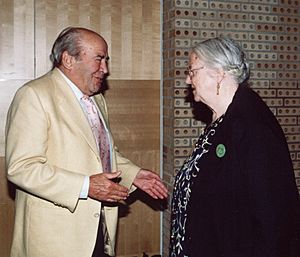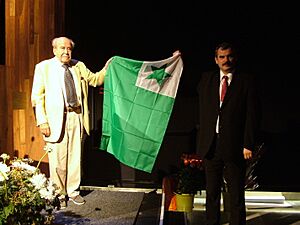Louis-Christophe Zaleski-Zamenhof facts for kids
Quick facts for kids
Louis-Christophe Zaleski-Zamenhof
|
|
|---|---|

Louis-Christophe Zaleski-Zamenhof and Marjorie Boulton, another prominent Esperantist (2003).
|
|
| Born |
Ludwik Zamenhof
23 January 1925 |
| Died | 9 October 2019 (aged 94) Paris, France
|
| Nationality | French |
| Parents |
|
| Relatives | Zofia Zamenhof (aunt) Lidia Zamenhof L. L. Zamenhof (grandfather) |
Louis-Christophe Zaleski-Zamenhof (born Ludwik Zamenhof; 23 January 1925 – 9 October 2019) was an engineer from Poland and France. He was an expert in designing structures made of steel and concrete. He was the grandson of L. L. Zamenhof, who created the international language called Esperanto. From the 1960s until he passed away, Zaleski-Zamenhof lived in France.
Contents
Early Life and Challenges
Zamenhof was born in Warsaw, Poland, into a Jewish family. During World War II, his father, Adam Zamenhof, was arrested and killed by the Nazis who had taken over Poland.
Louis-Christophe and his mother, Wanda, barely escaped being sent to a very dangerous Nazi camp called Treblinka. His aunts, Zofia and Lidia Zamenhof, sadly died there.
As a teenager, he stayed hidden in Poland using a different name, 'Krzysztof Zaleski'. He kept this name later to remember the difficult time he went through.
A Secret Revealed
While in hiding, he worked in a tomato field with a Polish man. This man happened to speak Esperanto. One day, the man asked him, "Ĉu vi konas Esperanton?" (which means "Do you know Esperanto?").
'Christoph' quickly replied, "Ho jes, mi konas; ĝin inventis mia avo!" ("Oh yes, I know it; my grandfather invented it!"). He was immediately worried that he had said too much and might be caught, but nothing bad happened.
Engineering Career
After finishing his studies and earning a doctorate in civil and marine engineering, Louis-Christophe Zaleski-Zamenhof became a professional engineer.
He started his work in Poland after World War II. From the 1960s onwards, he worked in France. He designed many structures, including special concrete buildings. His projects included large platforms in the ocean for oil, sports stadiums, and the Charles de Gaulle Memorial in France.
He also taught about how to build things on land and at sea at different universities.
Tolerance Medal Award
In 1999, Zaleski-Zamenhof presented the first "Tolerance Medal" from the Zamenhof Foundation of Białystok. He gave this award to Pope John Paul II during the Pope's visit to Poland. This award was created to honor people who promote understanding and tolerance.
He also wrote an introduction for a French book called L'homme qui a défié Babel (which means "The man who defied Babel"). This book was a biography about his grandfather, the creator of Esperanto.
Speeches at Esperanto Congresses
Louis-Christophe Zaleski-Zamenhof often gave speeches at the World Congress of Esperanto. These are big meetings for people who speak Esperanto from all over the world.
Importance of Dialogue
In a speech in 2001, he talked about the importance of talking and understanding different cultures. He reminded everyone that his grandfather created Esperanto because he saw how people from different backgrounds in his city didn't understand each other.
He explained that a common language helps people talk and respect other cultures. Without this understanding, a different culture might seem strange or even unfriendly. He pointed out that words like "strange" in English and "étrange" in French can mean "odd" or "peculiar," and also "foreigner."
He believed that Esperanto, as a neutral language, helps people from different language groups feel equal. It helps them respect other cultures without forcing one way of thinking on anyone.
Celebrating Diversity
In 2002, he sent a message to the World Congress in Brazil. He said that humans are meant to be diverse. He praised Brazil for its many different natural places, people, customs, and cultures.
He compared the worldwide Esperanto community to a "great family circle." He encouraged people to see cultural differences as a good thing, not as a threat.
Memories of Freedom
In 2003, he spoke at the World Congress in Sweden. He remembered how, 60 years earlier during World War II, the city of Gothenburg in Sweden meant human rights and freedom to him and his family.
He recalled that when they were trapped in the Warsaw Ghetto, packages of food from Gothenburg would arrive. He especially remembered the sender, Einar Adamson, an Esperanto speaker. He met Adamson in 1948 and became friends with his family.
He also called for peace among people and for everyone to have the right to speak their chosen language, including Esperanto. He also asked for support to end world hunger.
Zamenhof Street Book
Louis-Christophe Zaleski-Zamenhof was very dedicated to the Esperanto cause. He often greeted the World Congresses on behalf of the Zamenhof family.
A Polish journalist named Roman Dobrzyński convinced him to share his life story. They had many conversations over ten years, which led to a book called La Zamenhof-strato ("Zamenhof Street").
The book tells about his life during the Nazi occupation of Poland, including his experiences in the Warsaw Ghetto and his involvement in the Polish resistance. Besides his own story, the book also talks about the ideas, history, and challenges of the Esperanto movement started by his grandfather. It also looks at what the future might hold for the language. This book has been published in many languages.
Later Life and Legacy
Louis-Christophe Zaleski-Zamenhof passed away in 2019. His daughter, Margaret Zaleski-Zamenhof, continues to be active in the Esperanto community today.
See also
 In Spanish: Louis-Christophe Zaleski-Zamenhof para niños
In Spanish: Louis-Christophe Zaleski-Zamenhof para niños


